|
|
|
Central Street 100th
Posted
10/20/03
|
|
|
|
 |
|
|
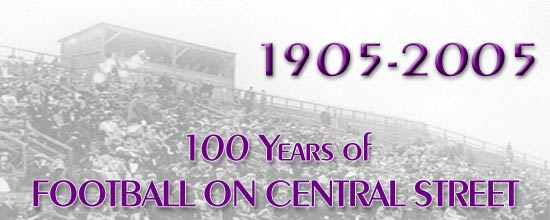

The 2005 season is being
celebrated as the tenth anniversary of the team that brought the
Wildcats back to Pasadena, but it is another, less well-known
landmark. This season marks the 100th anniversary of the
dedication of Northwestern Field and the beginning of NU football
played on Central Street.
Football had, of course, been played on campus long before Northwestern
Field was built. Previously, NU had played its games on Sheppard
Field, where the present-day fraternity quads stand and, earlier, on a
field where Deering Meadow now is (for timelines and details of these
football sites, check the Home Sites Page). By 1903,
however, the popularity of NU football demanded a new venue, one away
from the more cramped conditions of the campus by the lake and larger
than Sheppard Field's meager 2,000 standing room only capacity.
NU business manager William Dyche took up the charge to plan and raise
sufficient funds for a new site. As NU coach Walter McCornack's
teams continued to win and pick up fans, the need for a new, larger
site became increasingly urgent. NU played the last portion of
its 1903 home schedule at the White Sox's park because of the need for
seats. Nine of the Purple's ten games in 1904 were home games; NU
played all but the last in old Sheppard Field. NU's game with
Illinois on November 12, 1904 was the last played at Sheppard, and the
last on-campus home game NU ever played east of Sheridan Road. By
then the plans for a new stadium had been announced, and fans knew the
significance of the meeting with the Illini (which NU won, 12-6).
The following week NU hosted Minnesota, not on campus, but at the
University of Chicago's Marshall Field.
Work soon began on the new site, which was located northwest of NU's
main campus, on Central Street. By September 1905 work finished
on the wooden stands of the Northwestern Athletic Field, which
initially held 10,000 fans. The dedication of the new site was to
be held on October 14, but NU began playing at the site nearly a month
before the ceremony. On Wednesday afternoon, September 20, NU
hosted Evanston Township H.S. and beat the high schoolers 32-0.
The Purple played one more high school warm up game and games against
two small colleges (winning all of them in shut outs) before the formal
dedication.
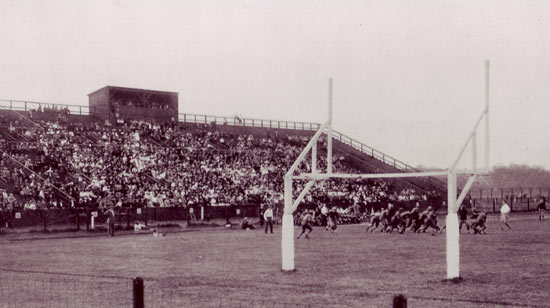
On Saturday, October 14, 1905 Northwestern hosted Beloit College and
formally dedicated its new Central Street facility.* Edward
Dunne, mayor of Chicago, was the guest of honor and led the
procession to the
stadium. A carriage containing Dunne and other guests rolled down
Central Street, followed by horses and the NU Marching Band, formally
organized just two years before.
At the time, NU released an announcement, stating "The fact that
Northwestern University now has an unsurpassed athletic field is a
source of great gratification to all the friends of the University.
"Northwestern Field, containing 12 acres of ground, equipped with a
base-ball diamond, splendid foot-ball gridirons, banked quarter-mile
track and 220 yards straightaway, having permanent seating capacity for
10,000 people, and temporary stands this season for 1,000 more, and
with a club-house containing ample dressing rooms, shower baths, etc.,
for the athletic teams, was made possible by the earnest work of
friends of Northwestern University.
"The Board of Trustees of Northwestern University set aside this land
some time ago to be used for athletic purposes. The cost of
improvements on the land preparing the contest fields, building stands,
club houses, etc., will amount to about $25,000.
|
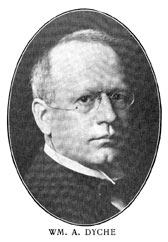
NU business manager
William Dyche
|
". . . Much
of the success of securing this field is due to the earnest work of
John T. Barker, mayor of Evanston, and William A. Dyche, ex-mayor of
Evanston and now business manager of Northwestern University."
Graduate manager Frank O. Smith described the site at its dedication as
"a new field equalled by few and surpassed by none. The land
selected by the trustees was admirably fitted for its present use
|
Front page of the game program.
|
in its natural state. . .
The grand stands seating seventy-five hundred people are regarded by
competent critics as the best arranged and most stable in existence.
"The committee planned to provide for all the athletic interests of our
student body. The land set aside by the University trustees is
sufficient to accommodate not only the athletic sports in which
students are now interested, but lacrosse, association football, and
other sports as well, and it is the hope of the athletic committee that
a permanent interest may be aroused in more branches of sport at
Northwestern University."
When NU and Beloit took
the field to kick off the dedication game, Chicago mayor Dunne
presented the game ball to NU captain Arthur Rueber and to Beloit's
captain.
The Purple struggled with Beloit initially. The visitors scored a
safety on NU, the first points NU had given up in the season. But
NU star running back Jimmy Johnson eventually broke the match open,
rushing for 200 yards and two touchdowns, and Northwestern beat Beloit
18-2. NU had also beaten Beloit during the 1892 dedication game
for the Sheppard Field grandstands.
|
The Purple played five straight games at Northwestern
Field after the dedication with Beloit, winning three of them and
compiling a total record of eight wins, one loss and one tie. All
ten of their games so far had been held on their new field. By
the end of November, NU faced its final game, its only away game, a
monstrous road match with dominant Minnesota. By this time the NU
squad was riddled with injuries, its star, Johnson, was ailing, and
rumors had begun to swirl that the University was considering
disbanding the varsity team and doing away with intercollegiate
football. Under those conditions, it was no wonder that Minnesota
routed the previously strong Purple team.
NU did, in fact, disband its football team in Spring 1906, citing,
among other reasons, the injuries and deaths that had happened at other
schools (but not, interestingly, at NU itself), and it looked like the
Central Street facility would have been used for just one season.
However, interclass teams were given priority and began to play at
Northwestern Field in 1906 and 1907. To the school's dismay, the
intramural and class games were every bit as violent (actually, more
so) as the head-knocking intercollegiate brand. The University
allowed the varsity team to reform, with a very limited schedule, in
1908, and intercollegiate football returned to Central Street.
Northwestern Field remained NU's football site until the end of the
1925 season. Its successor, Dyche Stadium, was also built on
Central Street, with the field positioned just a few feet to the east
of the old field. So when you stand in the Ryan Field west stands this
year, remember: it was 100 years ago on that very spot
that Northwestern began playing its own maddening, frustrating,
exhilarating, and thrilling brand of Central Street Football.
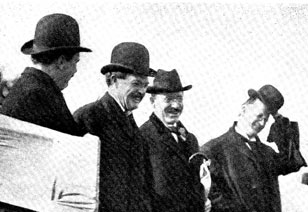 Dignitaries at the official dedication of Northwestern
Field.
Dignitaries at the official dedication of Northwestern
Field.
Left to right: Evanston mayor John Barker, Chicago mayor
Edward F. Dunne, NU president Thomas Holgate, and NU
business manager William A. Dyche.
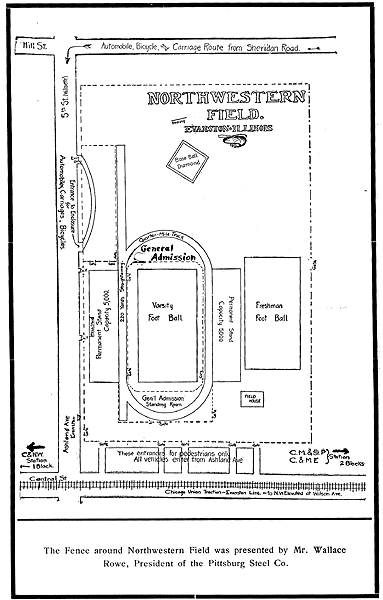
The original plan for the
Northwestern Field complex. Note the
Chicago Union train that ran right down Central Street at the time.
The freshman football field is located roughly on the same spot where
Dyche Stadium was built in 1926.
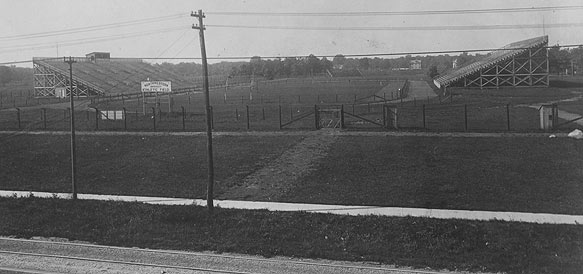
The view of Northwestern
Field from Central Street (the train tracks are visible in the
foreground). The west parking lot is now located on this site.
*For some reason, NU considers the 1905 game
with Beloit an away game, and it is listed as an away game in the Media
Guide. The game was clearly a home game and was, in fact, the
Dedication Game for Northwestern Field, as attested by the game's
program and contemporary write-ups of the game in the Daily Northwestern, the Chicago Tribune, and the Syllabus.
All photographs on this page are from the NU Archives.
This page is an expanded version of the account given in the book Northwestern Wildcat Football.
|


|
|
|

